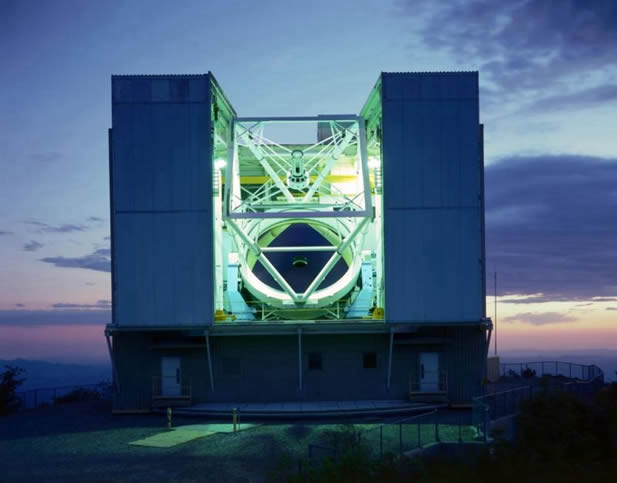Multiple Mirror Telescope (MMT)
The Multiple Mirror Telescope
(MMT) is located on the summit of Mt Hopkins, on the grounds of the
Smithsonian Institution's Fred
Lawrence Whipple Observatory, 55 kilometers south of Tucson, Arizona.

Web Site: http://www.mmto.org/
Lead Investigator (redshift campaign, 2007A): Dr Ann Hornschemeier
Lead Investigator (redshift campaign, 2008A): Dr Ron Marzke
Lead Investigator (stellar populations): Dr Russell Smith
When astronomers look out into space, in the direction of the Coma cluster, they do not immediately know which galaxies actually reside within the cluster. Many galaxies may, and in fact are, located at distances far beyond the Coma cluster. Therefore, to properly study the Coma cluster requires the identification of true galaxy members. We are using the Hectospec instrument on the 6.5 meter MMT on Mount Hopkins, Arizona, to observe thousands of galaxies in the center of the Coma cluster and in several fields in the cluster outskirts. Hectospec is a spectrograph fed by 300 optical fibres positioned to gather light from many galaxies simultaneously over a field-of-view one degree in diameter (twice the full moon). The fibres can be re-positioned in only 15 minutes, so that the overall observing efficiency is very high. Using observations of one hour per fibre configuration, we have measured some 7000 redshifts in the direction of the Coma cluster. In the process we have discovered hundreds of new cluster members, while definitively removing most of the background contaminants. In addition, the spectra allow us to probe the large-scale structure of (i.e., the distribution of galaxies in) the Universe behind the Coma cluster.
A second strand to the Hectospec observations is to study in detail the properties of selected galaxies within the cluster. For a set of 150 brighter dwarf elliptical galaxies, we repeatedly assign spectrograph fibres in many Hectospec configurations, eventually building up a total exposure of up to ten hours duration. The result are very high-quality spectra which are used to determine the `age' of each galaxy (i.e., how long ago its last stars were formed) and the typical chemical composition of the gas from which the stars formed. The ages can be analyzed to distinguish how star-formation in galaxies has been influenced by the growth of the Coma Cluster itself. For example, we have found evidence that dwarf galaxies have been inactive for 10 billion years (i.e., for most of the 13.7 billion year history of the Universe) in the cluster core, but similar galaxies in the outer regions of the cluster were forming stars only a few billion years ago. This is evidence for environment-driven shutdown of star formation as new galaxies fall into the cluster, and suggests at least some of the faint red galaxies were formed recently by infalling, star-forming, field galaxies.
